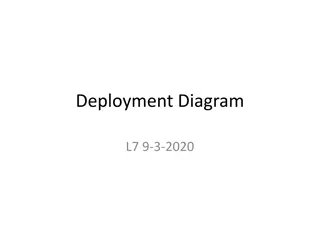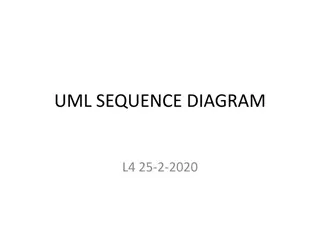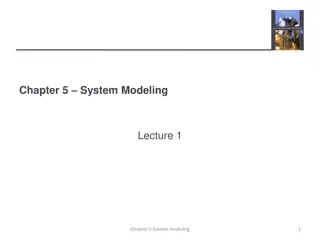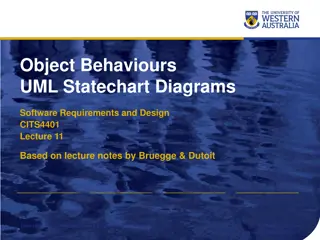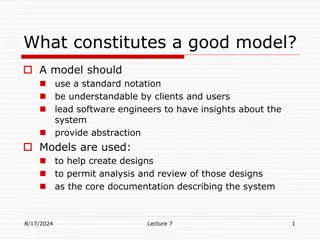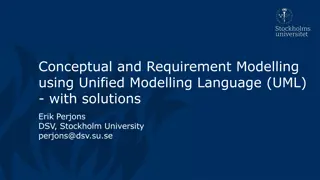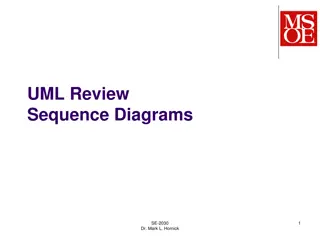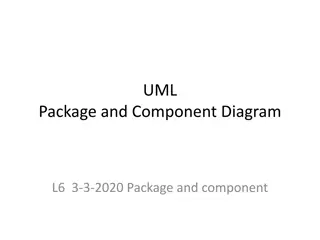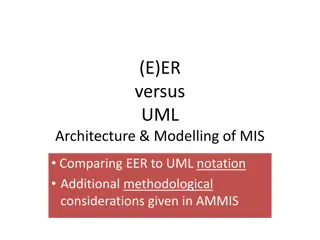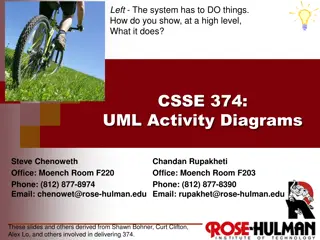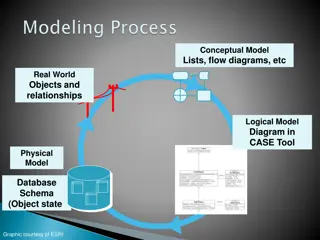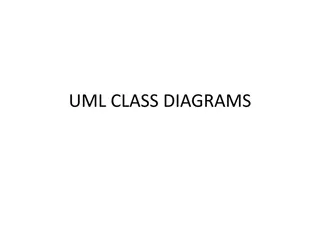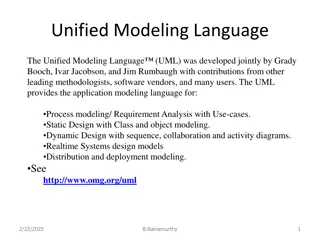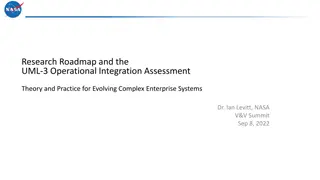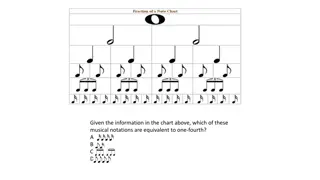Software Analysis and Design Process
Software analysis and design involve a systematic approach to understanding user requirements, creating logical models, and transitioning to detailed design specifications. Requirements analysis focuses on capturing system requirements, while design translates these requirements into implementation
11 views • 16 slides
UML Deployment Diagrams
UML Deployment Diagrams show the execution architecture of software systems, illustrating how software deployment targets are assigned artifacts to nodes. Nodes represent hardware devices or software environments connected through communication paths, while artifacts are concrete elements deployed o
8 views • 22 slides
Evolution of Modeling Methodologies in Telecommunication Standards
Workshop on joint efforts between IEEE 802 and ITU-T Study Group 15 focused on information modeling, data modeling, and system control in the realm of transport systems and equipment. The mandate covers technology architecture, function management, and modeling methodologies like UML to YANG generat
3 views • 16 slides
UML Sequence Diagrams and Their Applications
UML sequence diagrams depict how objects interact in a given scenario, showcasing messages sent between targets on lifelines. They are valuable for detailing use cases, modeling logic, task flow between components, and understanding process functionality. Objects, boundaries, controls, and stereotyp
3 views • 30 slides
System Modeling in Engineering
System modeling in engineering involves developing abstract models to represent a system from various perspectives using graphical notations like UML. These models aid in understanding system functionality, communicating with stakeholders, and documenting requirements for new systems. Existing and p
9 views • 53 slides
Object Behaviors and Statechart Diagrams in Software Design
Object behaviors and UML statechart diagrams play a crucial role in software requirements and design. State machines, transitions, events, and states are essential concepts in modeling object behavior in response to external events. By utilizing UML statechart diagrams, one can effectively represent
4 views • 23 slides
UML for Effective Software Design
A good model should utilize standard notation, be easily understandable, and provide insights for software engineers. UML features, essentials of UML class diagrams, and details on classes, associations, and multiplicity are covered. The objective is to assist in software development through abstrac
5 views • 48 slides
Conceptual and Requirement Modelling Using UML
Enterprise and system models play a crucial role in the business world. This collection of images showcases various aspects of conceptual and requirement modelling using Unified Modelling Language (UML). From business process models to human interactions with software systems, these visual represent
1 views • 92 slides
UML Sequence Diagrams
UML Sequence Diagrams illustrate high-level interactions between class instances in software programs. They represent method calls and interactions among objects during program execution. The diagrams show interactions for specific circumstances like startup or button clicks. Each class/object is re
1 views • 8 slides
UML Package Diagrams and Components in Software Design
UML package diagrams are essential in organizing model elements such as use cases and classes into groups for a better structure in system modeling. They help in providing a high-level overview of requirements and architecture, logically modularizing complex diagrams, and indicating dependencies bet
5 views • 38 slides
Comparing EER and UML Architecture for Modelling of MIS
This discussion delves into the comparison between Entity-Relationship (EER) and Unified Modeling Language (UML) architectures for the modelling of Management Information Systems (MIS). It explores the differences in notation, methodological considerations, specialisation hierarchies, and categorisa
4 views • 16 slides
UML Activity Diagrams in Software Design
UML Activity Diagrams provide a modern way to visualize business processes, workflows, data flows, and complex algorithms in software systems. They use symbols to represent different parties involved, actions performed, transitions, and control flows. These diagrams help in modeling data flows, obje
3 views • 14 slides
Data Modeling and Database Schema Design
Explore various aspects of data modeling, ranging from conceptual to physical models, using tools like CASE Tool and ArcGIS. Learn about entity-relationship diagrams, UML notations, and diagrammatic notations in the context of constructing data models. Discover the significance of classes, relations
2 views • 20 slides
Object-Oriented Systems Analysis and Design (OOSAD) Using Unified Modeling Language (UML)
Explore the fundamentals of object-oriented analysis and design using UML, a powerful tool for constructing and visualizing systems. Learn about object-oriented concepts, classes, inheritance, UML diagrams, use case modeling, activity and sequence diagrams, and more. Discover how UML can enhance the
4 views • 144 slides
UML CLASS DIAGRAMS
UML class diagrams are like family trees for software applications, representing classes and interfaces as important entities in a hierarchical structure. They help in visualizing relationships, collaborations, and system design details, converting system requirements into detailed designs. Class di
1 views • 20 slides
Introduction to Activity Diagram in UML
An activity diagram in UML visually represents the sequence of activities and workflow in a system, detailing decision paths and parallel processing. It is useful for business modeling and can depict various elements like actions, control flow, nodes, and regions.
4 views • 21 slides
Unified Modeling Language - Application Modeling for Software Development
Unified Modeling Language (UML) is a powerful tool developed by Grady Booch, Ivar Jacobson, and Jim Rumbaugh for modeling various aspects of software development. It encompasses phases like requirement analysis, object-oriented design, system development, and testing. Use-case modeling and component
2 views • 18 slides
Essential Parts of Business Letters
In the realm of business communication, understanding the vital components of a well-crafted letter is crucial. Learn about attention lines, subject lines, reference initials, attachment/enclosure notations, copy notations, blind copy notations, and second-page headings. Master the nuances that enha
5 views • 8 slides
Research Roadmap and the UML-3 Operational Integration Assessment
A research roadmap is a living document that guides the progression of complex system capabilities through high-level requirements, assumptions, and constraints. It provides valuable insights for evolving enterprise systems. The integration of UML-3 operational assessment theory facilitates the deve
2 views • 33 slides
UML Introductions
UML, a visual modeling language, plays a crucial role in software development. This article provides insight into UML diagrams, their significance, and practical applications in designing complex software systems. Explore different types of UML diagrams for capturing system requirements and architec
4 views • 24 slides
Asymptotic Series: Properties and Notations
Asymptotic series play a crucial role in analyzing functions as their magnitude grows. Explore the properties and notations of asymptotic series, including Big O and Small o notations. Learn how these series show the behavior of functions as their input values increase.
2 views • 39 slides
Object-Oriented Design and UML Refresher
This content provides insights into Object-Oriented Design (OOD) and UML concepts, focusing on Class Diagrams, Associations, Generalization, and Implementations. It discusses the meanings and visual representation of "is-a," "has-a," and "needs-a" relationships, emphasizing minimal clutter in diagra
1 views • 33 slides
UML - Types of Diagrams, Notations, and Hierarchies
Learn about UML (Universal Modeling Language) and its significance in software design. Explore different types of diagrams such as class, object, use case, and more. Gain insights into notations for classes, objects, inheritance, and states in UML. Understand the hierarchy of UML elements and discov
2 views • 14 slides
Introduction to Object-Oriented Programming with UML
Explore the fundamentals of Object-Oriented Programming with UML, a standardized graphical modeling language in Software Engineering. Understand the goals, characteristics, and importance of UML in system design and development. Learn about conceptual modeling and creating UML class diagrams.
5 views • 37 slides
Musical Notations, Candy Sales, Student Demographics, Monthly Expenses, Pizza Fraction, Sound Travel Calculation
Explore various math problems involving musical notations, candy sales percentages, student demographics, monthly expenses breakdown, fractions, and sound travel calculations. Answer questions on equivalent musical notations, sold candy percentages, gender distribution, color percentages, favorite m
2 views • 13 slides
IBM Rational Software Architect Introduction and UML Modelling Overview
Learn about IBM Rational Software Architect (RSA) and UML modelling with Aman Quadri. This overview covers the basics of RSA, workspace management, perspectives, interactive lab environment, and hands-on exercises. Explore the applicability matrix, lab activities, and suggestions for SDLC choices ba
15 views • 9 slides
Improvements in DATEX II Version 3.0 Methodology and Features
Explore the enhancements made in the methodology of DATEX II Version 3.0, including improvements in UML 2 and a modular approach. Learn about the lessons learned, clearer meta-model, and the resolution of minor issues, all discussed at the DATEX II User Forum in Dublin. Discover the major improvemen
1 views • 11 slides
Object-Oriented Modeling and UML Overview
The concepts of objects, classes, attributes, and relationships in object-oriented modeling. Learn how UML represents object-oriented systems through various diagrams like class, interaction, and state chart diagrams.
4 views • 34 slides
Introduction to UML Timing Diagrams
UML timing diagrams visually represent the change in state or value of elements over time. They show interactions between timed events, time constraints, and duration constraints governing them. Elements include state lifelines and value lifelines, each displaying changes over time. Learn how state
1 views • 9 slides
Introduction to UML Timing Diagrams
UML timing diagrams display changes in state or value of elements over time. They show interactions between timed events, time constraints, and duration constraints. Elements include state lifelines, value lifelines, and how they can be stacked together. This example-rich guide covers the basics and
1 views • 12 slides
Asymptotic Notations for Algorithm Complexity Analysis
Learn about asymptotic notations such as Big Theta, Big O, and Big Omega to analyze the running time of algorithms in relation to input size. Explore how these notations describe the rate of growth of functions and establish bounds for algorithm efficiency.
3 views • 36 slides
The Significance of UML in Software Development
Explore the history, definition, and significance of Unified Modeling Language (UML) in software development. Learn why UML is essential for specifying, visualizing, and documenting software systems. Discover what UML is not and its role in standardizing methodologies.
0 views • 50 slides
Business Process Modelling with UML Activity Diagrams
Explore how to model business processes using UML Activity Diagrams, understanding Control Flow, Information Flow, and Parallel Behaviours. Learn how to represent the order and flow of actions in a formal business process modelling language.
0 views • 17 slides
Understanding UML Activity Diagrams: Workflow Visualization and Decision Paths
Learn how UML activity diagrams portray the sequence of actions, workflow, and decision paths in a structured format. Explore the various elements like actions, control flow, decision nodes, objects flow, and more that aid in representing complex processes effectively.
0 views • 16 slides
Understanding UML Modeling and Class Diagrams in Software Engineering
Learn about UML modeling and class diagrams, essential tools in software engineering for creating abstract models of systems. Explore the different components, relationships, and types of diagrams used for designing and visualizing software structures.
0 views • 19 slides
Mastering UML Class Diagrams: Tools and Techniques
Explore the art of creating UML class diagrams step by step, from selecting the right classes to telling a compelling story with your diagrams. Learn about tools like White Star UML and understand key concepts such as generalization, composition, and aggregation. Enhance your software design skills
4 views • 18 slides
Understanding Software Modeling and UML: An Overview
Explore the history and significance of Unified Modeling Language (UML) in software development. Learn how UML helps in visualizing, specifying, constructing, and documenting object-oriented systems. Discover who UML is for and the basics of modeling. Dive into the importance of modeling in software
0 views • 32 slides
Understanding UML - A Comprehensive Overview
Explore the world of Universal Modeling Language (UML) and its significance in software development. Learn about the different types of diagrams, UML hierarchy, notation, and more. Dive into the details of UML notations, inheritance, association, states, interfaces, and interaction diagrams to enhan
2 views • 16 slides
Understanding Asymptotic Notations
Learn about Big-O, Big-Omega, Theta, small-o, and small-omega notations in the context of analyzing algorithm efficiency. From defining the notations to understanding relationships between different functions, explore the world of asymptotic notations visually explained with examples.
1 views • 18 slides
Understanding Unified Modeling Language (UML)
Discover the essence of Unified Modeling Language (UML), a standard language for visualizing, constructing, and documenting software systems. Explore the goals of UML, its conceptual model, object-oriented concepts, and the process of Object-Oriented Analysis and Design. Unravel the fundamental buil
1 views • 15 slides

